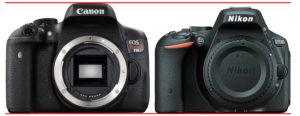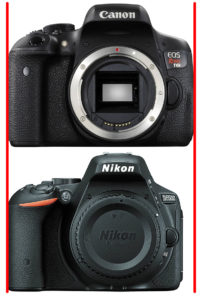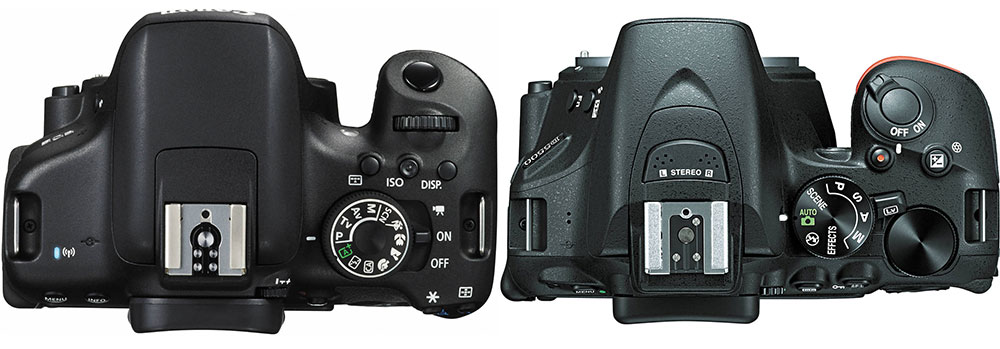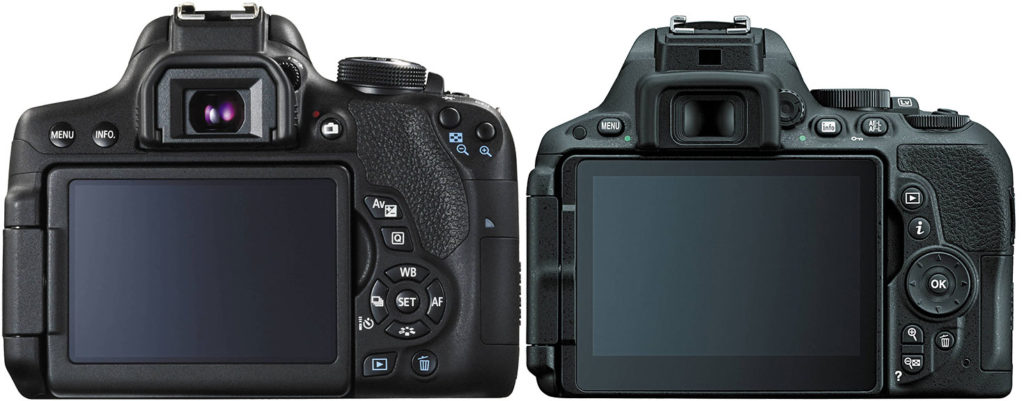Canon EOS Rebel T6i vs Nikon D5500 Camera Comparison
The Canon EOS Rebel T6i and the Nikon D5500 are two very popular cameras that are frequently compared side-by-side as they are both similarly priced and spec’ed. They are not a perfect comparison as each camera has a few features that the other camera does not. In the end selecting the best camera for you will come down not only to the features of each camera, but part of the entire eco system of each manufacturer. Be sure to look at the lenses, flashes and other accessories each company offers when making your ultimate decision.
Side by Side
Canon EOS Rebel T6i Pricing*
- Body Only - $749.99
- Body with 18-55 IS STM Lens - $899.99
- Body with 18-135mm IS STM Lens - $1099.00
Check current pricing from these affiliates
Nikon D5500 Pricing*
- Body Only - $699.95
- Body with AF-S DX 18-55mm f/3.5-5.6 VR II Lens - $799.95
- Body with AF-S DX 18-140mm f/3.5-5/.6 VR Lens - $1199.95
Check current pricing from these affiliates
*Pricing from Manufacturer's website - Current selling price may be different. Be sure to visit the links below for current pricing.
Canon EOS Rebel T6i Advantages
- The Rebel T6i offers a Battery Grip option allowing you to load 2 batteries at the same time as well as a vertical shutter release.
- the Canon Rebel T6i LCD is higher resolution on paper, the difference is so small that you won’t even notice it in actual use.
- The Canon has an advantage for aspiring videographers who want to control their audio better by using an external microphone
- The Canon has more direct controls whereas the Nikon relies on the user going into the menu to make many changes.
- the Canon offers a larger/faster buffer which is useful when shooting in burst mode – more images are captured before the camera has to slow down to finish processing the images it has taken.
- The Canon features wireless TTL flash control with the built-in flash
- The Canon offers a “Mirror lock Up” mode to help prevent blurring due to the mirror slap action on longer exposures.
Nikon D5500 Advantages
- The D5500 offers (slightly) better battery life
- The Nikon D5500 is a fair bit lighter in weight an slightly smaller than the Canon Rebel T6i.
- The Nikon D5500 LCD Screen is slightly larger than the Canon Rebel but the difference is not very noticeable in actual side by side comparison.
- The addition of the 60fps video of the Nikon D5500 over the Rebel T6i’s 30fps allows you to shoot fast action that can be slowed down and still looks nice and smooth.
- The Nikon D5500 sensor is slightly larger than the Canon Rebel T6i which in theory can help with higher ISO performance.
- The D5500 does not have an AA filter which can help to provide sharper images since AA filters are designed to slightly blur the image to help prevent moire.
- Having more white balance options helps to control the color in your images with the Nikon D5500, but most advanced amateurs will shoot in auto white balance and adjust in Post.
- The Nikon D5500 is able to track movement more accurately – especially in the 3D tracking mode. The 3D tracking mode in the Nikon D5500 is great for sports and action shooting, but note the burst mode limitations of the Nikon D5500.
- AF Assist is a bit of a distraction and I typically turn it off, but the Nikon is a little more discrete than the Canon which uses the pop-up flash for AF assist.
Conclusion
This is an easy comparison or a difficult one to make. If you already own a Canon, then I would suggest the Canon T6i if you are looking for a newer camera or an upgrade from one of the older Rebels, and if you already own a Nikon, I would recommend the Nikon D5500. But if you are starting from scratch the decision is a lot harder.
Both cameras are pretty evenly specified, with one camera offering certain better features than the other. Depending on what your goals are one camera begins to stand out based on what you are shooting. One thing that is not visible in the specs above is accessibility to settings. If you plan to learn to adjust the settings then the Canon starts to hold a big advantage over the Nikon since a number of the settings have dedicated buttons and controls. Also, the ability to shoot a remote speedlight wirelessly and the ability to use a battery grip make the Canon my choice for the more serious beginning to intermediate photographers (advanced photographers are typically looking at the next camera level and higher).
One other thing to consider is the size and feel of the camera. I would strongly suggest you handle both cameras as the way each feels in your hand may be the best way to decide which one is for you. Another thing to consider is not only the camera, but the entire system – check out the available lenses, flashes and other accessories you may be interested in purchasing as part of your decision process.
One final suggestion, if you have friends or family members that own one or the other brand it can be a good idea to buy into the same brand so that you can share lenses, accessories and experience with each other as your are learning and growing as a photographer.
Canon EOS Rebel T6i Overall User Rating
4.71 out of 5
based on 848 user reviews online.
: 82% (697.03)
: 13% (107.13)
: 2% (15.28)
: 1% (10.14)
: 2% (18.42)
Nikon D5500 Overall User Rating
4.76 out of 5
based on 641 user reviews online.
: 83% (529)
: 14% (87)
: 2% (14)
: 1% (6)
: 1% (5)
Shop
Specs
| Spec | Canon EOS Rebel T6i | Nikon D5500 |
|---|---|---|
| Sensor Size | APS-C (1.6x) | APS-C (1.5x) |
| Megapixels | 24 | 24 |
| Body Construction | Plastic w/metal chassis | Carbon fiber, composite |
| Dimensions (WxHxD) | 5.2 x 4 x 3.1 in. | 4.88 x 3.82 x 2.76 in. |
| Weight | 1.22 lbs. | 0.93 lbs. |
| Weather Sealed | No | No |
| Memory Card | SD/SDHC/SDXC | SD/SDHC/SDXC |
| Dual Command Wheels | No | No |
| Viewfinder Type | Pentamirror | Pentamirror |
| Viewfinder Coverage | 95 | 95 |
| ISO Range | 100-12800 (Extended Mode: 100-25600) | 100-25600 |
| Mirror Lock Up | Yes | No |
| Burst Rate | 5 fps | 5 fps |
| LCD Size | 3 in. | 3.2 in. |
| LCD Resolution | 1,040,000 pixels | 1,037,000 pixels |
| Articulated LCD Screen | Tilt & Swivel | Tilt & Swivel |
| Touchscreen | Yes | Yes |
| Image Stabilization | No | No |
| Remote Shutter Release | Wired & Wireless (InfraRed) | Wired & Wireless (InfraRed) |
| WiFi | Yes | Yes |
| GPS | Optional | No |
| AF Points | 19 (all cross point - center Dual Cross Point f/2.8) | 39 |
| AF Sensitivity | EV -0.5 - 18 | -1ev to +19ev |
| Minimum Shutter Speed | 30 second | 30 second |
| Maximum Shutter Speed | 1/4000 seconds | 1/4000 seconds |
| Flash Sync Speed | 1/200 second | 1/200 second |
| Built In Flash | Yes | Yes |
| Wireless TTL Flash | Yes | No |
| Video Specs |
1920 x 1080: 30 fps, 25 fps, 24 fps 1280 x 720: 60 fps, 50 fps 640 x 480: 30 fps, 25 fps |
1920 x 1080 (60, 50, 30, 25, 24 fps) |
| Mic In | Yes | Yes |
| Headphone Out | No | No |
| Built In Mic | Stereo | Stereo |




